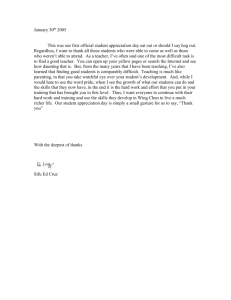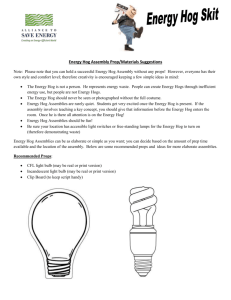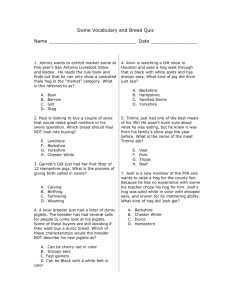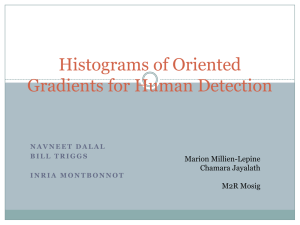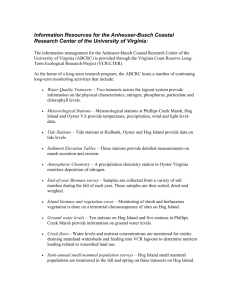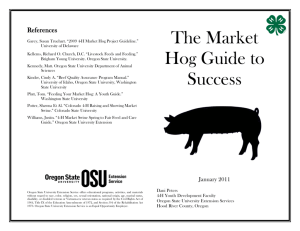Brainstorm the Affects of a Hog Farm
advertisement
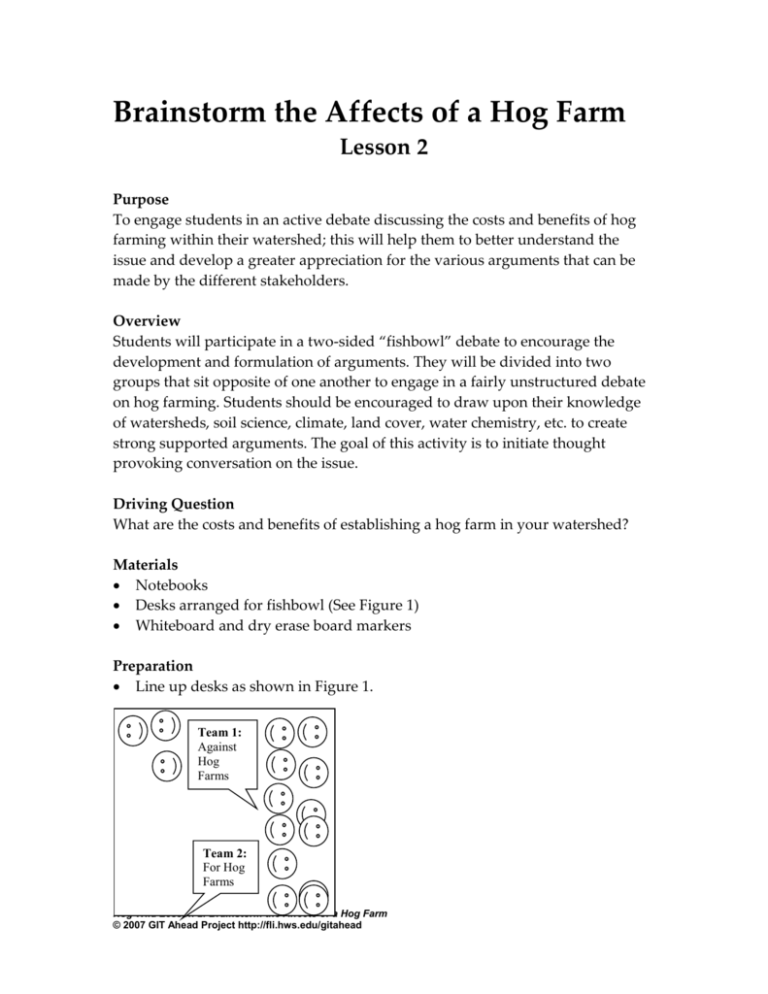
Brainstorm the Affects of a Hog Farm Lesson 2 Purpose To engage students in an active debate discussing the costs and benefits of hog farming within their watershed; this will help them to better understand the issue and develop a greater appreciation for the various arguments that can be made by the different stakeholders. Overview Students will participate in a two-sided “fishbowl” debate to encourage the development and formulation of arguments. They will be divided into two groups that sit opposite of one another to engage in a fairly unstructured debate on hog farming. Students should be encouraged to draw upon their knowledge of watersheds, soil science, climate, land cover, water chemistry, etc. to create strong supported arguments. The goal of this activity is to initiate thought provoking conversation on the issue. Driving Question What are the costs and benefits of establishing a hog farm in your watershed? Materials Notebooks Desks arranged for fishbowl (See Figure 1) Whiteboard and dry erase board markers Preparation Line up desks as shown in Figure 1. Team 1: Against Hog Farms Team 2: For Hog Farms Hog Wild Lesson 2: Brainstorm the Affects of a Hog Farm © 2007 GIT Ahead Project http://fli.hws.edu/gitahead Figure 1. Desks Arranged for "Fishbowl." Time 1 class period. Allow half the class period for the debate and half the period for debrief. Learning Objectives Students will be able to articulate and express in their own words the costs and benefits of hog farming in the Finger Lakes Region. Students will be able to recognize, interpret, and summarize their own arguments as well as their peers. Assessment Criteria Students will be assessed on the quality and nature of their arguments in the fishbowl. Students will also be graded on their one-page Fishbowl argument homework assignment assigned in the lesson 1. Procedure 1. Facilitate a fishbowl debate for and against the establishment of a hog farm. a. Divide students into two teams assigned in the previous lesson. b. Ask each student team to sit in two rows that are facing the other team as shown in Figure 1. c. Review the structure of the Fishbowl debate. “One side will argue in support of establishing a new hog farm and the other side will argue against the establishment of a hog farm. Also, remember that only students in the first row of each team can speak to the students in the first row of the other team. The role of students in the second row is to whisper ideas or suggestions to students in the first row. But if you are in the second row you may not speak to the opposing team directly.” d. Provide students with the focus question, “Should we establish a new hog farm in the _______ watershed.” Write this question on the board for students to see. e. Allow the teams to debate the issue for 5-10 minutes. f. Ask the students within a team switch rows (first and second rows) and continue the debate and add another question directly related to your watershed. Write the question on board. Hog Wild Lesson 2: Brainstorm the Affects of a Hog Farm © 2007 GIT Ahead Project http://fli.hws.edu/gitahead g. Ask the students to switch rows one or two more times. Again focus the debate with statements or questions related to your watershed. Write the question on the board. 2. Debrief the experience with the students and clearly identify the costs and benefits of establishing a hog farm cited in their watershed, by listing them on the whiteboard. a. “Did your perspective change or broaden during the Fishbowl debate after hearing statements and points of view expressed by your classmates.” b. “Do you think you can better relate to the different extreme perspectives of the hog farming debate?” c. “How does the perspective and position of a stakeholder influence the argument?” d. “What are the costs and benefits of hog farming in the ________ watershed?” [List costs and benefits on whiteboard.] Hog Wild Lesson 2: Brainstorm the Affects of a Hog Farm © 2007 GIT Ahead Project http://fli.hws.edu/gitahead
